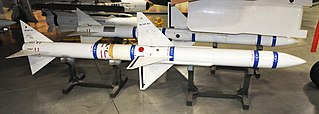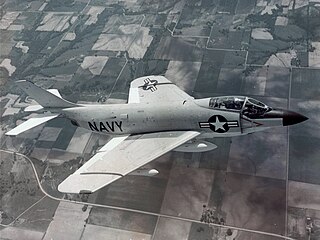
The AIM-7 Sparrow is an American medium-range semi-active radar homing air-to-air missile operated by the United States Air Force, United States Navy, United States Marine Corps, and various other air forces and navies. Sparrow and its derivatives were the West's principal beyond visual range (BVR) air-to-air missile from the late 1950s until the 1990s. It remains in service, although it is being phased out in aviation applications in favor of the more advanced AIM-120 AMRAAM.
The AIM-120 Advanced Medium-Range Air-to-Air Missile(AMRAAM) ( AM-ram) is an American beyond-visual-range air-to-air missile capable of all-weather day-and-night operations. It uses active transmit-receive radar guidance instead of semi-active receive-only radar guidance. When an AMRAAM missile is launched, NATO pilots use the brevity code "Fox Three".

The AIM-54 Phoenix is an American radar-guided, long-range air-to-air missile (AAM), carried in clusters of up to six missiles on the Grumman F-14 Tomcat, its only operational launch platform.

Fighter aircraft are military aircraft designed primarily for air-to-air combat. In military conflict, the role of fighter aircraft is to establish air superiority of the battlespace. Domination of the airspace above a battlefield permits bombers and attack aircraft to engage in tactical and strategic bombing of enemy targets.

The McDonnell F3H Demon is a subsonic swept-wing carrier-based jet fighter aircraft designed and produced by the American manufacturer McDonnell Aircraft Corporation. It was the first swept wing jet fighter and the only single-engined carrier-based fighter the company produced.

The Advanced Short Range Air-to-Air Missile (ASRAAM), also known by its United States designation AIM-132, is an imaging infrared homing air-to-air missile, produced by MBDA UK, that is designed for close-range combat. It is in service in the Royal Air Force (RAF), replacing the AIM-9 Sidewinder. ASRAAM is designed to allow the pilot to fire and then turn away before the opposing aircraft can close for a shot. It flies at well over Mach 3 to ranges in excess of 25 kilometres (16 mi). It retains a 50 g maneuverability provided by body lift technology coupled with tail control.

An air-to-air missile (AAM) is a missile fired from an aircraft for the purpose of destroying another aircraft. AAMs are typically powered by one or more rocket motors, usually solid fueled but sometimes liquid fueled. Ramjet engines, as used on the Meteor, are emerging as propulsion that will enable future medium- to long-range missiles to maintain higher average speed across their engagement envelope.

The RIM-7 Sea Sparrow is a U.S. ship-borne short-range anti-aircraft and anti-missile weapon system, primarily intended for defense against anti-ship missiles. The system was developed in the early 1960s from the AIM-7 Sparrow air-to-air missile as a lightweight "point-defense" weapon that could be retrofitted to existing ships as quickly as possible, often in place of existing gun-based anti-aircraft weapons. In this incarnation, it was a very simple system guided by a manually aimed radar illuminator.

The Hughes AIM-4 Falcon was the first operational guided air-to-air missile of the United States Air Force. Development began in 1946; the weapon was first tested in 1949. The missile entered service with the USAF in 1956.

Infrared homing is a passive weapon guidance system which uses the infrared (IR) light emission from a target to track and follow it seamlessly. Missiles which use infrared seeking are often referred to as "heat-seekers" since infrared is radiated strongly by hot bodies. Many objects such as people, vehicle engines and aircraft generate and emit heat and so are especially visible in the infrared wavelengths of light compared to objects in the background.

The MIM-72A/M48 Chaparral is an American-made self-propelled surface-to-air missile system based on the AIM-9 Sidewinder air-to-air missile system. The launcher is based on the M113 family of vehicles. It entered service with the United States Army in 1969 and was phased out between 1990 and 1998. It was intended to be used along with the M163 VADS, the Vulcan ADS covering short-range short-time engagements, and the Chaparral for longer range use.

The Mitsubishi F-1 is a Japanese swept-wing, single-seat, twin-engine supersonic strike aircraft that was in service with the Japan Air Self-Defense Force (JASDF) from 1978 to 2006. It was Japan's first domestically designed and built supersonic combat aircraft, jointly developed by Mitsubishi Heavy Industries. It is essentially a T-2 trainer airframe modified for a dedicated anti-ship and ground attack role.

The AIM-97 Seekbat or XAIM-97A Seek Bat was a long-range air-to-air missile developed by the United States. It was intended to counter the perceived capabilities of the Mikoyan-Gurevich MiG-25 and proposed to arm both the F-15 Eagle and F-4 Phantom, the missile ultimately never entered service.

The AIM-95 Agile was an air-to-air missile developed by the United States. It was developed by the US Navy to equip the F-14 Tomcat, replacing the AIM-9 Sidewinder. Around the same time, the US Air Force was designing the AIM-82 to equip their F-15 Eagle, and later dropped their efforts to join the Agile program. In the end, newer versions of Sidewinder would close the performance gap so much that the Agile program was canceled.

The AN/AWG-9 and AN/APG-71 radars are all-weather, multi-mode X band pulse-Doppler radar systems used in the F-14 Tomcat, and also tested on TA-3B. It is a long-range air-to-air system capable of guiding several AIM-54 Phoenix or AIM-120 AMRAAM missiles simultaneously, using its track while scan mode. The AWG-9 utilizes an analog computer while the APG-71 is an upgraded variant utilizing a digital computer. Both the AWG-9 and APG-71 were designed and manufactured by Hughes Aircraft Company's Radar Systems Group in Los Angeles; contractor support was later assumed by Raytheon. The AWG-9 was originally created for the canceled Navy F-111B program.
The Air Combat Evaluation (ACEVAL) and the Air Intercept Missile Evaluation (AIMVAL) were two back-to-back Joint Test & Evaluations chartered by the United States Department of Defense that ran from 1974-78 at Nellis Air Force Base in Nevada. Both the U.S. Air Force and U.S. Navy participated, contributing a team of F-15 Eagle and F-14 Tomcat fighter aircraft and using the local F-5E Aggressor aircraft as the Red Force. The fundamental question that needed to be answered was one of "quantity vs quality". Mock engagements showed that cheaper, lower-technology fighters armed with all-aspect missiles were able to destroy the more advanced, expensive F-15's and F-14's. These results of the AIMVAL/ACEVAL testing led to the Air Force decision to structure its fighter forces with a balance of cheaper F-16's along with the more expensive F-15's, and the Navy took a similar strategy in procuring cheaper F/A-18's along with the more expensive F-14's. The results had other impacts as well, such as decisions regarding missile development.

The MAA-1 Piranha is a short-range infrared homing missile and the first air-to-air missile developed by Brazil for its Air Force and Navy. It was designed to replace the AIM-9 Sidewinder missile in Brazilian service and has since been exported to Colombia, Indonesia and Pakistan.

The AIM-9 Sidewinder is a short-range air-to-air missile. Entering service with the United States Navy in 1956 and the Air Force in 1964, the AIM-9 is one of the oldest, cheapest, and most successful air-to-air missiles. Its latest variants remain standard equipment in most Western-aligned air forces. The Soviet K-13, a reverse-engineered copy of the AIM-9B, was also widely adopted.

The General Dynamics Mauler was a self-propelled anti-aircraft missile system designed to a late 1950s US Army requirement for a system to combat low-flying high-performance tactical fighters and short-range ballistic missiles.

The Short Range Air-to-Air Missile, or SRAAM for short, initially known as Taildog, was an experimental British infrared homing air-to-air missile, developed between 1968 and 1980 by Hawker Siddeley Dynamics. It was designed to be very manoeuvrable for use at short range in a dogfight situation. SRAAM was unusual in that it was launched from a launch tube instead of being attached to a launch rail, allowing two to be carried on a single mounting point.

















